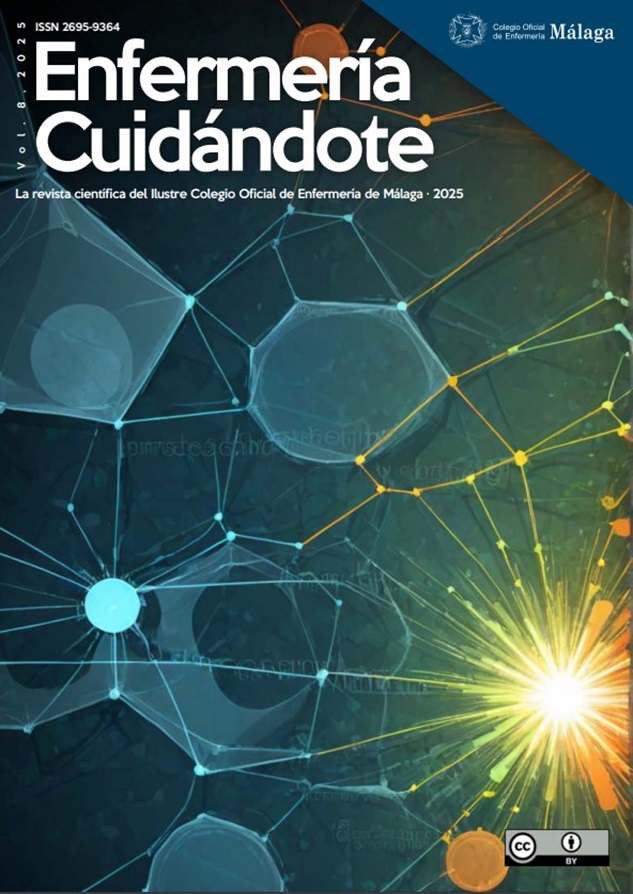Efficacy of acetic acid as an antiseptic in chronic infected wounds: a narrative literature review
DOI:
https://doi.org/10.51326/ec.8.2765359Keywords:
Acetic Acid, Anti-Infective Agents, Pseudomonas, Wound InfectionAbstract
Background: Acetic acid is associated with the treatment of wounds infected by Pseudomonas aeruginosa, an opportunistic pathogen with high antimicrobial resistance. The objective of this review is to assess the antimicrobial effectiveness of acetic acid in infected chronic wounds, clarifying its clinical safety, cytotoxicity, and the most effective concentration and application format.
Methods: A bibliographic review of the literature by pairs was carried out in four databases (Pubmed, Tripdatabase, Cochrane Library and Lilacs), performing a screening by two reviewers with blinding of the articles obtained. Systematic reviews, meta-analyses, clinical practice guidelines, randomized trials, observational trials, and case series were included.
Discussion: 932 articles were obtained, analyzing eight: 2 case series, 1 expert consensus, 1 ECA, 1 RCT, 1 quasi-experimental study, 1 narrative review and 1 systematic. There is consensus on the effectiveness of acetic acid as an antimicrobial, especially against Pseudomonas aeruginosa and Staphylococcus aureus. Concentrations >2% caused pain and ≥5% burning and burns. The most used format was impregnated gauzes.
Conclusions: Acetic acid offers good results as antiseptic, especially against pseudomonas. These findings should be associated with the significantly lower costs of this treatment. No contraindications were described, although adverse events exist at high concentrations. There is great clinical variability when using the product, either due to its concentration, application time, format or spacing. A shortage of quality studies has been detected, especially RCTs; more quality evidence is needed.
Downloads
References
Elhage KG, St Claire K, Daveluy S. Acetic acid and the skin: a review of vinegar in dermatology. Int J Dermatol. 2022;61(7):804-811. https://doi.org/10.1111/ijd.15804
Taylor K. Treatment of Bacillus Pyocyaneus Infection. J Am Med Assoc. 1916;LXVII(22):1598-9. https://doi.org/10.1001/jama.1916.02590220040013
Phillips I, Lobo AZ, Fernandes R, Gundara NS. Acetic acid in the treatment of superficial wounds infected by Pseudomonas aeruginosa. Lancet. 1968;1(7532):11-4. https://doi.org/10.1016/s0140-6736(68)90004-4
Todar K. Todar’s Online Textbook of Bacteriology. Madison (Wisconsin): University of Wisconsin-Madison Department of Bacteriology; 2020. Pseudomonas. Disponible en: https://textbookofbacteriology.net/pseudomonas.html [Consultado 20-11-2023]
Chen S, Rudoy R, Windle ML, Lutwick LI, Steele RW, Krilov LR. Pseudomonas Infection. Newark (New Jersey): Medscape; 5 de mayo de 2025. Disponible en: https://emedicine.medscape.com/article/970904-overview [Consultado 23-11-2023]
Hall-Stoodley L, Stoodley P, Kathju S, Høiby N, Moser C, Costerton JW, Moter A, Bjarnsholt T. Towards diagnostic guidelines for biofilm-associated infections. FEMS Immunol Med Microbiol. 2012 Jul;65(2):127-45. https://doi.org/10.1111/j.1574-695x.2012.00968.x
Organización Mundial de la Salud. Ginebra: Organización Mundial de la Salud; 2024. Resistencia a los antibióticos; 31 de julio de 2020. Disponible en: https://www.who.int/es/news-room/fact-sheets/detail/antibiotic-resistance [Consultado 20-11-2023]
Roldán Valenzuela A, Ibáñez Clemente P, Alba Moratilla C, Roviralta Gómez S, Casajús Tormo MT, Gutiérrez Vargas P., et al. Guía de Práctica Clínica: Consenso sobre úlceras vasculares y pie diabético de la Asociación Española de Enfermería Vascular y Heridas (AEEHV). 3ª ed. Barcelona: Asociación Española de Enfermería Vascular y Heridas; 2017. 140 p. Disponible en: https://aeevh.org/wp-content/uploads/2020/04/Guia-de-Practica-Clinica-web.pdf [Consultado 20-11-2023].
Rueda López J, Navarro Picó M, Álvarez Hernández A, Blanco Blanco J, Blasco Gil S, Chaverri Fierro D, et al. Limpieza de las heridas, soluciones, presión y técnicas. Logroño: Grupo Nacional para el Estudio y Asesoramiento en Úlceras por Presión y Heridas Crónicas; 2023. Disponible en: https://gneaupp.info/wp-content/uploads/2023/05/gneaupp.dt17.limpieza.pdf [Consultado 21-11-2023]
Sen CK. Human Wounds and Its Burden: An Updated Compendium of Estimates. Adv Wound Care (New Rochelle). 2019;8(2):39-48. https://doi.org/10.1089/wound.2019.0946
Nair HKR, Mrozikiewicz-Rakowska B, Sanches Pinto D, Stuermer EK, Matiasek J, Lázaro-Martínez JL, et al. International Consensus Document: Use of wound antiseptics in practice. London: Wounds International; 2023. Disponible en: https://gneaupp.info/wp-content/uploads/2023/10/multi23-cd-antiseptic-wint-web-v2-1.pdf [Consultado 21-11-2023]
Ouzzani M, Hammady H, Fedorowicz Z, Elmagarmid A. Rayyan-a web and mobile app for systematic reviews. Syst Rev. 2016;5(1):210. https://doi.org/10.1186/s13643-016-0384-4
Chen Q, Zhou K. Acetic Acid Use in Chronic Wound Healing: A Multiple Case Series. J Wound Ostomy Continence Nurs. 2022;49(3):286-9. https://doi.org/10.1097/won.0000000000000863
Leow LJ, Zubrzycki N. Recalcitrant Ulcerative Pyoderma Gangrenosum of the Leg Responsive to Tildrakizumab: A Case Report. Clin Cosmet Investig Dermatol. 2022;15:1729-36. https://doi.org/10.2147/ccid.s374534
Kramer A, Dissemond J, Kim S, Willy C, Mayer D, Papke R, et al. Consensus on Wound Antisepsis: Update 2018. Skin Pharmacol Physiol. 2018;31(1):28-58. https://doi.org/10.1159/000481545
Madhusudhan VL. Efficacy of 1% acetic acid in the treatment of chronic wounds infected with Pseudomonas aeruginosa: prospective randomised controlled clinical trial. Int Wound J. 2016;13(6):1129-36. https://doi.org/10.1111/iwj.12428
Cwajda-Białasik J, Mościcka P, Szewczyk MT. Antiseptics and antimicrobials for the treatment and management of chronic wounds: a systematic review of clinical trials. Postepy Dermatol Alergol. 2022;39(1):141-51. https://doi.org/10.5114/ada.2022.113807
Tarricone A, De La Mata K, Chen S, Krishnan P, Landau S, et al. Relationship Between pH Shifts and Rate of Healing in Chronic Nonhealing Venous Stasis Lower-Extremity Wounds. J Foot Ankle Surg. 2020;59(4):748-52. https://doi.org/10.1053/j.jfas.2020.01.007
Fejfarová V, Tibenská H, Niklová J, Bém R, Dubský M, Wosková V, et al. Benefits of Acidifying Agents in Local Therapy of Diabetic Foot Ulcers Infected by Pseudomonas sp: A Pilot Study. Int J Low Extrem Wounds. 2019 Sep;18(3):262-8. https://doi.org/10.1177/1534734619848573
Ryssel H, Kloeters O, Germann G, Schäfer T, Wiedemann G, Oehlbauer M. The antimicrobial effect of acetic acid--an alternative to common local antiseptics? Burns. 2009;35(5):695-700. https://doi.org/10.1016/j.burns.2008.11.009
Barrigah-Benissan K, Ory J, Sotto A, Salipante F, Lavigne JP, Loubet P. Antiseptic Agents for Chronic Wounds: A Systematic Review. Antibiotics (Basel). 2022;11(3):350. https://doi.org/10.3390/antibiotics11030350
McCauley RL, Linares HA, Pelligrini V, Herndon DN, Robson MC, Heggers JP. In vitro toxicity of topical antimicrobial agents to human fibroblasts. J Surg Res. 1989;46(3):267-74. https://doi.org/10.1016/0022-4804(89)90069-3
Cooper ML, Laxer JA, Hansbrough JF. The cytotoxic effects of commonly used topical antimicrobial agents on human fibroblasts and keratinocytes. J Trauma. 1991;31(6):775-84. https://doi.org/10.1097/00005373-199106000-00007
Geng RSQ, Sibbald RG, Slomovic J, Toksarka O, Schultz G. Therapeutic Indices of Topical Antiseptics in Wound Care: A Systematic Review. Adv Skin Wound Care. 2025;38(1):10-8. https://doi.org/10.1097/asw.0000000000000233
Loureiro Rodríguez MT, Rosendo Fernández JM, Antón Fuentes VM, Bello Jamardo AM, Esperón Güimil JA, Fiel Paz L, et al. Impacto de un proyecto de enfermería en el cuidado de las heridas crónicas. Gest Eval Cost Sanit. 2014;15(3):265-83. Disponible en: https://www.fundacionsigno.com/archivos/publicaciones/06.pdf [Consultado 23-11-2023]




















